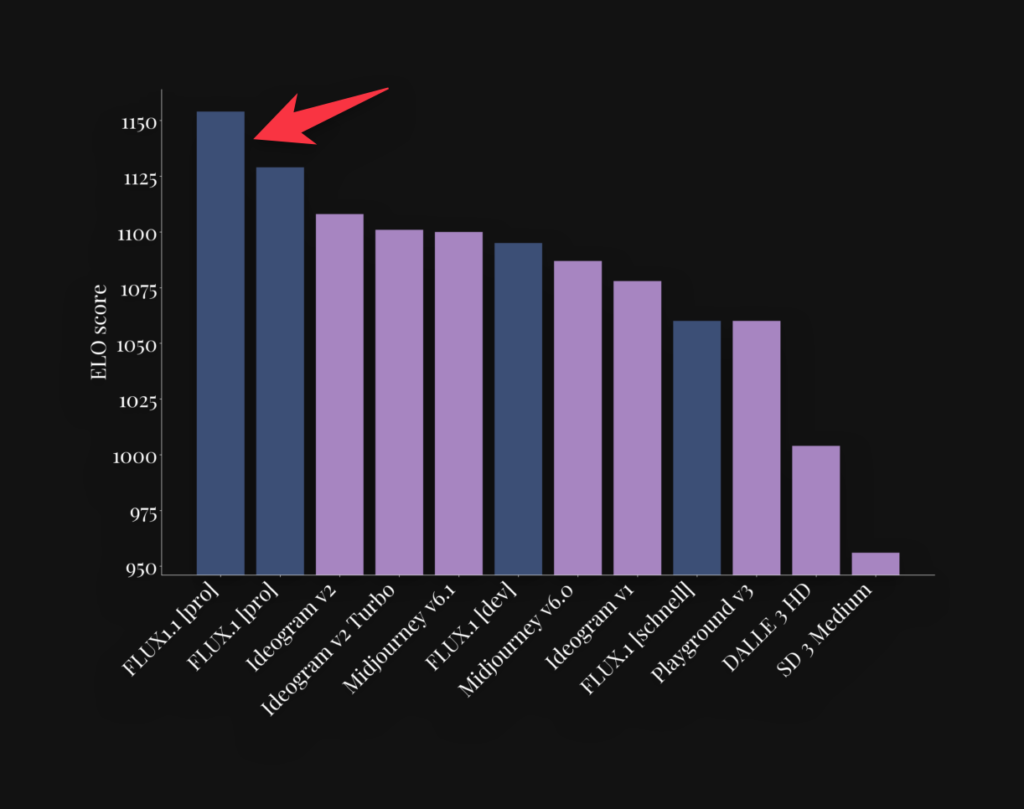The line between reality and fiction is becoming increasingly blurred thanks to constant advances in the field of artificial intelligence image generation. Black Forest Labs has just launched its new AI model, Flux 1.1 pro (Codename Blueberry), and early feedback seems to indicate that this is the best AI image generator currently available.
With six times faster image generation and significantly improved image quality, Flux 1.1 pro is a real step up from its predecessor Flux.1.
More realistic, faster, cheaper
Since its inception, Flux, and particularly Flux 1.1 pro, has been praised for its speed and efficiency. The 1.1 model is now capable of generating images in under 5 seconds, putting it head and shoulders above its competitors.
In blind tests, Flux 1.1 pro showed breathtaking results, outperforming models like Stable Diffusion and achieving very high Elo scores thanks to its speed and affordable access costs.
In terms of costs, Black Forest Labs’ genius also lies in its pricing strategy.
Flux 1.1 pro costs around 4 cents per megapixel, making image creation extremely affordable.
Platforms like together.ai allow users to explore these features at no upfront cost, with a few dozen generations free.
Key features of Flux 1.1 pro
Improved image quality
The results of Flux 1.1 pro display a nettiness and clarity that were absent in previous versions, with a more realistic rendering of textures.
Adherence to prompts
The model better understands user requests, producing images that faithfully adhere to the given specifications.
Visual diversity
The generation engine offers a wide range of stylistic options and variations, allowing you to explore new visual creations.
Comparisons with other AI image generators
In a fiercely competitive environment, Flux 1.1 pro stands out from the crowd.
In comparative tests with the likes of Midjourney and Ideogram, Flux 1.1 pro stood out not only for its speed, but also for the overall quality of the images produced.

For example, when testing with images of a woman taking a selfie, Flux rendered a theme not yet explored by other models.
To illustrate this performance, recently in blind tests, it was observed that Flux 1.1 achieved a success rate of 69%, far ahead of other competing models.
This positions Flux as aleader in image generation technologies.
Performance
The performance of Flux 1.1 pro goes beyond mere statistics. In various blind tests, the model was pitted against other image generators, pushing its capabilities to the extreme.
Natural renderings
Complex prompts were handled surprisingly well, with convincing results that showcased the model’s creativity and precision.
It’s also interesting to note that Flux 1.1 pro responded well to specific demands such as the generation of amateur-looking photos which, impossible for many AI models, was successfully achieved.
Using prompts like “selfie.JPEG”, users were able to produce images resembling real photographs taken by humans, totally blurring the line between the real and the artificial.
Limitations of Flux 1.1 pro
Like any technology, Flux 1.1 pro has its advantages and limitations.
- Complexity of prompts: Although Flux 1.1 pro has an appreciated adherence to prompts, some users still note difficulties with requests asking it for more abstract or artistic elements.
- Problems with certain details: As observed in various tests, hand and finger generation remains a challenge for many AI models, and Flux 1.1 pro is no exception.
The future of AI imaging
The launch of Flux 1.1 pro represents not only a technical breakthrough, but also a revelation about the future of AI-generated imaging.
The democratization of access to powerful tools for creating ultra-realistic visual content puts the technology within the reach of all users, from amateurs to professionals.
As we discussed in our previous article on Flux.1, this development also raises questions about the ethics and use of image-generating technologies.
As these tools become more accessible, it is essential to inform the public of the speculative evolution of technologies in order to avoid misinformation and misuse such as Deep fakes.
The generation of AI videos is even more problematic at this level, we have seen the impressive capacity and realism of models such as SORA or more recently the Meta video generator.
In addition, the fact that templates such as Flux 1.1 pro are open source also allows the community to innovate and make constant improvements to the template, which enables these tools to grow rapidly.
In conclusion: Flux is a tool to watch
Will Flux be able to dethrone the major players in generative AI for images, such as Midjourney, Dali, stable Diffusion and Leonardo?
We invite you to share your experiences with Flux 1.1 pro, whether you’re a designer, a technophile, or simply curious.
What results have you achieved with Flux 1.1 pro?
If you want to use Flux.1 we have two articles that may be useful.
AI NEWSLETTER
Stay on top of AI with our Newsletter
Every month, AI news and our latest articles, delivered straight to your inbox.

CHATGPT prompt guide (EDITION 2024)
Download our free PDF guide to crafting effective prompts with ChatGPT.
Designed for beginners, it provides you with the knowledge needed to structure your prompts and boost your productivity
With this ebook, you will:
✔ Master Best Practices
Understand how to structure your queries to get clear and precise answers.
✔ Create Effective Prompts
The rules for formulating your questions to receive the best possible responses.
✔ Boost Your Productivity
Simplify your daily tasks by leveraging ChatGPT’s features.
Similar posts
Flux.1 : How to create ultra-realistic AI images in just a few clicks
Flux.1, developed by Blackforest Labs, is a powerful tool for creating high-quality AI images with an ease of use that appeals to beginners and experienced users alike. To find out …
Flux.1, the new ultra-realistic image generator
Generative AI has not finished surprising us. Among recent innovations in this field, the Flux.1 model stands out as a true revolution for the generation of realistic and artistic images. …
How to generate ultra-realistic images locally with Flux.1?
Using Flux.1 locally is a great option for those looking to harness the full power of this AI image generation model without relying on an online platform. Here’s a detailed …


